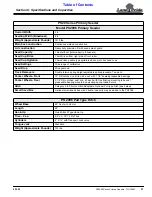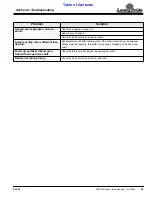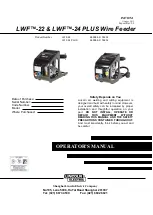
14
Section 3: Operating
PS2096 Series Primary Seeders 313-308M
6/15/10
Table of Contents
General Description
The following information is a brief description of how this
Primary Seeder works. It is included to help you
understand the operation of this seeder.
The power to drive the seeding function of this seeder
comes from the ground speed of the tractor. The seed
metering is powered by the front roller at a rate
proportional to the distance driven. This ensures that the
rate applied in pounds per acre or pounds per 1000
square feet remains constant as ground speed is varied.
The power is transmitted via drive chains to the seed cups.
This drive can be adjusted to a high or low range to
broadcast more or less seed. The seed rate is adjustable
using the seed rate lever located at the rear of the seeder.
The seed is dropped between cast iron rollers. The front
roller crushes clods, presses down small stones and
forms a firm seedbed. The rear roller firms the soil around
the seeds.
Operating Check List
In addition to design and configuration of equipment,
hazard control and accident prevention are dependent
upon the awareness, concern, prudence and proper
training involved in its operation, transport, maintenance
and storage of equipment. Before beginning to operate
your Primary Seeder, the following inspection should be
performed.
.
Check
Reference
Read and follow the “Safety Rules”
carefully.
Important Safety
Information
Read all of the “Tractor Hook Up” and
preparation instructions.
Section 2
page 14
“Basic Operations” in this Manual
Operator’s
Manual
Lubricate the seeder as needed. Refer to
“Lubrication”
Section 4
page 25
Check the seeder initially and periodically for
loose bolts & pins, “Torque Values Chart”.
Section 8
page 30
Make sure all guards and shields are in
place.
Operator’s
Manual
Check initially and periodically for loose bolts,
pins, and chains.
Operator’s
Manual
Inspect the seed cups and seed tubes for
foreign matter.
Section 4
page 29
Set speed change sprocket for drive type
desired.
Section 3
page 17
Set seed rate. See “Seed Rate Charts”.
Section 3
page 20
Seeder Preparation
Before proceeding with the first time set-up, or before
making any adjustments mentioned in this section, make
every effort to attach the seeder to a tractor.
1.
This seeder can be transported with a full box of
seeds. It is best not to do this unless necessary
because the increased weight does increase the
chances for problems on the road. Do not exceed 20
miles per hour.
2.
Calibrate your seeder for a proper rate based on the
seed you are using. Calibration information is located
on the inside of your box lid or on page 17.
3.
Make sure the seed cup door adjustment handle on
each cup is set the same across the seeder.
4.
Never allow anyone to ride on the seeder.
5.
Maximum seeding speed will vary according to soil
conditions.
6.
Check that all plugs and caps have been replaced
properly.
7.
Be sure all bolts and nuts are tight.
8.
Be certain all guards are in place and secure.
9.
Clear the area to be seeded of rocks, branches and
other foreign objects.
10. At first begin seeding at a slow forward speed and shift
up until the desired speed is achieved.
Tractor Requirements
This Primary Seeder is designed for tractors in the
Category 2 or 3 and Cat. 2 Quick Hitch. An optional pull
package is available for smaller tractors.
Check the tractor’s 3-point lifting capacity. Refer to
“Section 6: Specifications and Capacities” on Page 27
for seeder weight.
Tractor 3-Point Hook-Up
1.
Back tractor up to seeder until 3-Point links are
aligned with hitch clevises on seeder.
2.
Secure the tractor’s 3-Point lower arms to the lower
hitch clevises using hitch pins supplied.
3.
Secure tractor’s top center link to the seeder top hitch
using a 1” diameter hitch pin.
4.
With the seeder resting on level ground, adjust the
tractor’s top link until the seeder is level.
5.
Remove rear roller lock pin from parking position and
place in storage position. See Figure 2-1 on page 15.
NOTE: In order to maintain steering control, ballast
may have to be added to your tractor. To determine
whether or not to add ballast, refer to your tractor
operator’s manual.
Section 3: Operating



































